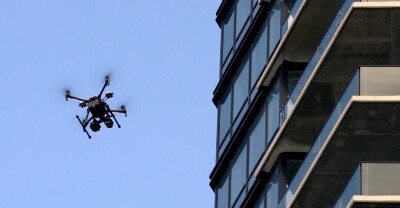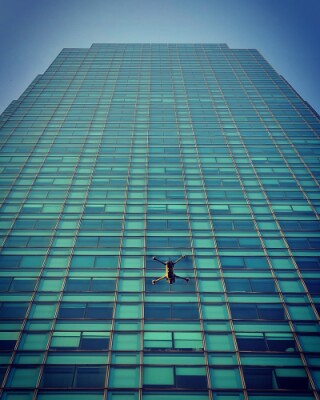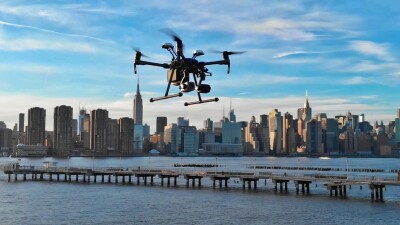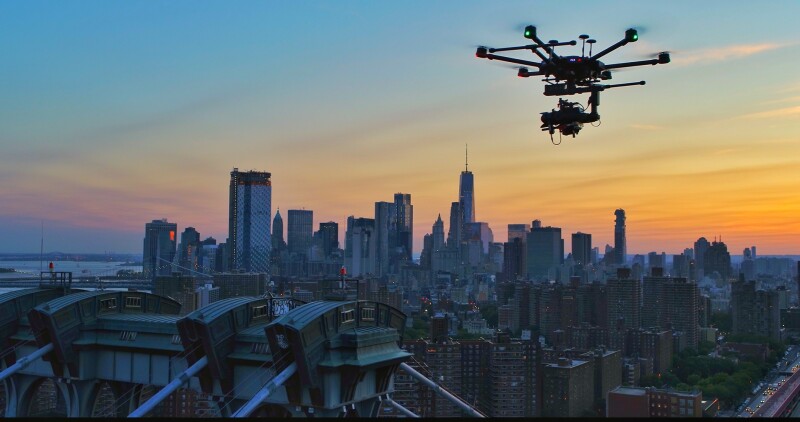Large cities like New York present a wide range of challenges for commercial drone operators. Tall buildings, narrow streets, and the constant presence of thousands upon thousands of cars, trucks, and people can create countless headaches for drone operators.
Drone companies, public officials, and members of the general public all have a stake in ensuring that drone operations are safe when conducted in cities. At the same time, all parties stand to benefit from drone technology, whether it is used for inspections, package delivery, or public safety.
Right now,  New York City is working through these challenges as it considers a bill that would allow uncrewed aerial systems to be used by the construction industry to assist the Department of Buildings (DOB) conduct façade inspections. Proponents of the bill say it would improve overall operations, enhance safety, and produce tremendous value.
New York City is working through these challenges as it considers a bill that would allow uncrewed aerial systems to be used by the construction industry to assist the Department of Buildings (DOB) conduct façade inspections. Proponents of the bill say it would improve overall operations, enhance safety, and produce tremendous value.
To learn more about the proposed bill—and the challenges drone operators face when working in dense, urban environments—Commercial UAV News spoke with Edward Kostakis, CEO of AeroSpect. A drone-based façade inspection company, AeroSpect has expanded to included services such as solar panel inspection, ground and roof top surveying, construction progress, LIDAR scanning, volumetric (stockpile) measurements, thermography, 3-D accident reconstruction, crane inspections, and cell tower inspection.
In our conversation, Kostakis discussed the current state of drone-based inspection work in New York City and what the future may hold.
Commercial UAV News: Explain the proposed legislation concerning façade inspections in New York City. What would the bill allow drone companies to do that they cannot do right now?
Kostakis: The proposed legislation would allow for building owners, surveyors, engineers, and architects to take advantage of a technology that has been around for the better part of a decade. This legislation would allow for drone technology to be implemented in the building inspection process. The drones would provide high resolution images while covering 100% of a building’s façade at a fraction of the time and  the cost that it would take using the more traditional methods. These traditional methods involve delivery, set up and break down of scaffolding that can stay up for months and in some cases years until the façade of a building has received its necessary repairs. Because of the amount of time it takes to undergo this process, it can become very expensive for those footing the bill. Moreover, scaffolding can be quite unsightly around the city and in many situations can present a danger themselves as the installation process can be hazardous and there have been many instances where items have fallen off of scaffolding injuring people on the sidewalks below including a complete collapse of the scaffolding themselves.
the cost that it would take using the more traditional methods. These traditional methods involve delivery, set up and break down of scaffolding that can stay up for months and in some cases years until the façade of a building has received its necessary repairs. Because of the amount of time it takes to undergo this process, it can become very expensive for those footing the bill. Moreover, scaffolding can be quite unsightly around the city and in many situations can present a danger themselves as the installation process can be hazardous and there have been many instances where items have fallen off of scaffolding injuring people on the sidewalks below including a complete collapse of the scaffolding themselves.
Commercial UAV News: Are there other benefits?
Kostakis: Applying drones in the building inspections process will not only save time and money for the building owners but will incentivize the necessary repairs needed to ensure a safer city for all. With that said, the use of drones will not replace the need for scaffolding. Scaffolding will always be necessary during many parts of the inspection and repair process however by using drones, what we are doing is reducing the amount of time scaffolding is required to remain installed and reducing the amount of scaffolding that ultimately gets installed. The passing of this bill would allow for building owners to hire companies like mine to assist them during the inspection process within the five boroughs of New York City.
Commercial UAV News: Discuss current regulations and restrictions regarding commercial drone operations in New York City.
Kostakis: Currently, the use of drones is illegal within the city limits. This is due to the “Avigation” law which was written back in the 1940’s. The Avigation law was originally written to be applied to manned aircraft, as at the time there were no drones. The purpose of the law was to restrict manned aircraft from landing in public spaces that were not designated by the city as an approved landing sight (airport/heliport). As drones became more popular, the city interpreted the law to include unmanned aircraft (drones) which has been the main reason drones are not allowed to be flown in NYC whether it be for commercial or hobbyist purposes.
Commercial UAV News: Given these regulations, what obstacles do New York drone operators currently face when developing drone-based projects?
Kostakis: Today in NYC, drone operators are faced with a confusing situation because the governing body of anything aviation related is the Federal Aviation Administration. According to the FAA, drone operators should be able to operate in NYC within the limits of the Federal Regulations pertaining to drones. However, the local regulation which is enforced by the NYPD says that it is illegal. Drone manufacturers, borough presidents and NYC members of council have tried amended this regulation for many years with no success. That is why another company I co-own (Xizmo Media), which uses drones for cinematography purposes, filed a lawsuit against the city two years ago in hopes of getting the law amended. The lawsuit is still ongoing. (To learn more about the lawsuit, click here.)
Commercial UAV News: If the bill passes, what will it mean for commercial drone operations in New York—and other cities?
Kostakis:  The future is very bright for drones assisting with façade inspections in dense urban environments, and it may be coming sooner than you think. There is so much to look forward to. Every day that goes by, drones are getting smaller, lighter, safer, and more capable during the data collection process. I believe that the DOB will have to rewrite some of its regulations to suit all the capabilities that drones can bring to the table once the regulation is amended. We are at a point in this city where many of the buildings that were built around the same period are starting to show dangerous and increasing levels of failure. Just last week, a parking garage in the financial district of Manhattan, which had been cited by the DOB multiple times, completely collapsed killing one and injuring many others. I believe the rate at which we see these buildings reaching complete failure will sharply incline as many of them were built to the same standard around the same time. Couple that with the amount of time it takes to inspect a building using the traditional methods along with the low amount of licensed façade inspectors licensed by the city, and we are looking at a situation that is bound to enter a bottleneck if it hasn’t already. Drones are a very elegant solution to this problem the city is facing, and we are looking forward to the coming changes.
The future is very bright for drones assisting with façade inspections in dense urban environments, and it may be coming sooner than you think. There is so much to look forward to. Every day that goes by, drones are getting smaller, lighter, safer, and more capable during the data collection process. I believe that the DOB will have to rewrite some of its regulations to suit all the capabilities that drones can bring to the table once the regulation is amended. We are at a point in this city where many of the buildings that were built around the same period are starting to show dangerous and increasing levels of failure. Just last week, a parking garage in the financial district of Manhattan, which had been cited by the DOB multiple times, completely collapsed killing one and injuring many others. I believe the rate at which we see these buildings reaching complete failure will sharply incline as many of them were built to the same standard around the same time. Couple that with the amount of time it takes to inspect a building using the traditional methods along with the low amount of licensed façade inspectors licensed by the city, and we are looking at a situation that is bound to enter a bottleneck if it hasn’t already. Drones are a very elegant solution to this problem the city is facing, and we are looking forward to the coming changes.















Comments